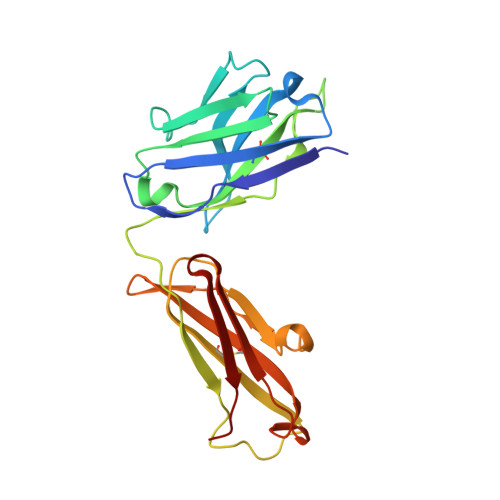Obstruction of Dengue Virus Maturation by Fab Fragments of the 2H2 Antibody.
Wang, Z., Li, L., Pennington, J.G., Sheng, J., Yap, M.L., Plevka, P., Meng, G., Sun, L., Jiang, W., Rossmann, M.G.(2013) J Virol 87: 8909-8915
- PubMed: 23740974
- DOI: https://doi.org/10.1128/JVI.00472-13
- Primary Citation of Related Structures:
3J42, 4KVC - PubMed Abstract:
The 2H2 monoclonal antibody recognizes the precursor peptide on immature dengue virus and might therefore be a useful tool for investigating the conformational change that occurs when the immature virus enters an acidic environment. During dengue virus maturation, spiky, immature, noninfectious virions change their structure to form smooth-surfaced particles in the slightly acidic environment of the trans-Golgi network, thereby allowing cellular furin to cleave the precursor-membrane proteins. The dengue virions become fully infectious when they release the cleaved precursor peptide upon reaching the neutral-pH environment of the extracellular space. Here we report on the cryo-electron microscopy structures of the immature virus complexed with the 2H2 antigen binding fragments (Fab) at different concentrations and under various pH conditions. At neutral pH and a high concentration of Fab molecules, three Fab molecules bind to three precursor-membrane proteins on each spike of the immature virus. However, at a low concentration of Fab molecules and pH 7.0, only two Fab molecules bind to each spike. Changing to a slightly acidic pH caused no detectable change of structure for the sample with a high Fab concentration but caused severe structural damage to the low-concentration sample. Therefore, the 2H2 Fab inhibits the maturation process of immature dengue virus when Fab molecules are present at a high concentration, because the three Fab molecules on each spike hold the precursor-membrane molecules together, thereby inhibiting the normal conformational change that occurs during maturation.
Organizational Affiliation:
Department of Biological Sciences, Purdue University, West Lafayette, Indiana, USA.















